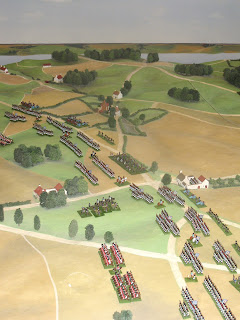WiP Basing and Some Away Games
Covert Sabots - Old-School Basing
The custom-made steel trays were commissioned from Essex Laser Job Shop Ltd., an expensive indulgence but worth it IMO. They were sprayed the same colour I use for my toy soldier bases. I hope you agree they are pretty unobtrusive, or covert, as per the title of this post.
As can be seen I use two magnets for cavalry figures as they are much heavier. While the magnets hold the figures well, they are not as secure as glued figures. Nonetheless it makes moving figures so much easier.
CHARGE the Rearguard
[Pre-Cabinette Archives c.2009! Hence the poor photos.]
This was my first attempt at a Table-top Teaser for my ‘toy soldier’ armies using Brigadier Young’s CHARGE rules. Not being blessed with a 9x7 foot table like Charles Grant I needed something that would draw out the action or it would all be over in few turns. To achieve this, I went a bit overboard, with the ‘armies’, separated by a river and entering over several turns; all in a rearguard scenario where one side would be seeking flight rather than fight. This was crammed on to my 8x5 foot table as shown below with the game in progress a few turns in.
The rest of the Austrians enter one unit per turn along the road at point A; which unit arrives being determined by a D6 as follows:
1 = Hussar sqn.
2 = Cuirassier regt.
3 = Hungarian Inf. regt.
4 = Austrian Inf. regt.
5 = Artillery battery #1
6 = Artillery battery #2
Unit arrival is diced for at the start of the turn, after order writing, and the unit will march on in column along the road. If the entry roll indicates a unit that is already on the table, the unit with the lowest arrival score that has yet to arrive is substituted. This mechanism should ensure that the lower numbered units arrive sooner.
The Bavarians mostly enter at Point B with some appearing at C or D; they dice for order of arrival in the same way (entry point in parentheses) as follows:
1 = Hussar sqn. (C)
2 = Militia regt. (D)
3 = Dragoon regt. (B)
4 = Bavarian Inf. regt. (B)
5 = Swiss Inf. regt. (B)
6 = Artillery battery #1 (B)
Before the game begins the Bavarian player rolls a D6 for each river section to determine which are fordable (4-6 on a D6). A sketch is drawn to record the results but is not shown to his opponent; the ticks and crosses on the map indicate which sections were fordable in the game as played and described below.
The Game: opened with few surprises; the Austrian hussars being the first to arrive to lead the army to safety while the Pandours pushed forward in skirmish order towards point B to delay the approaching Bavarian infantry.
The action developed rapidly over the next few moves as, spotting Bavarian militia approaching from the east (point D), ...
... the Austrians sent their hussars and Croats to seize the eastern bridge while still clear. The hussars overthrew the first militia company (see photo) their success underlining the value of cavalry and the frustrating absence of the Austrian cuirassiers.
While the hussars crashed into the militia across the bridge the arrival of the Bavarian hussars (at point C) convinced the Pandours that discretion was the better part of valour and they fell back to more defensible terrain covering the western bridge.
As more troops poured onto the table the Pandours effectively shielded their army’s flank as it marched at best speed to the eastern bridge.
The Pandours were reinforced by a company of Hungarian infantry to prevent any attempt to rush the bridge by the growing number of Bavarian units marshalled against them, while in the backround the rest of the Austrians can be seen making haste to reach the other bridge and safety.
The Bavarian superior numbers were brought to bear and the Pandours, and to a greater extent the more exposed Hungarians, started to take heavy losses from both musketry and artillery.
Finally, the much-anticipated Austrian cuirassiers arrived bringing up the rear of the column! The lackadaisical attitude of this unit of dawdlers continued as they marched along the road unconcerned by the sight of two squadrons of Bavarian dragoons eyeing them from the ridge across the river (north of point A). The cuirassiers’ composure was rudely shattered as the dragoons declared a charge on them – the possibility that the river might be fordable had been overlooked!
Somewhat unfairly these haughty cavaliers did not pay the price for their hubris, a scandalous sequence of lucky die rolls seeing them win the resulting melee. It now dawned on the Austrians that the river was not the reliable barrier they had assumed it to be and henceforth more caution was exercised.
As the casualties mounted in the firefight at the western bridge, the Austrian column reached the eastern bridge, now cleared of the militia by the hussars and Croats. On crossing, the Austrian infantry wheeled to their left to form a defensive line to shield the following units (see photo). This line was soon put under pressure as the Bavarians shifted their weight of effort from the western bridge to the eastern crossing.



























